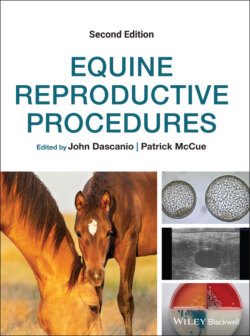Читать книгу Equine Reproductive Procedures - Группа авторов - Страница 77
Оглавление26 Antisperm Antibody Testing
Patrick M. McCue
Equine Reproduction Laboratory, Colorado State University, USA
Introduction
Antisperm antibodies (ASAs) have been suggested to be a cause of infertility in both males and females of a number of species, including mice, rabbits, cattle, horses, humans, and other species. IgG, IgA, and IgM antibodies directed against sperm antigens have been detected in various fluids and tissues.
Published studies have reported that 13–77% of women with unexplained infertility have ASAs detected in their serum. Mechanical or chemical disruption of the mucosal layer of the female genital tract has been proposed as the mechanism by which exposure to the “foreign” sperm antigen occurs. An immune response subsequently develops following exposure to sperm antigens.
Potential mechanisms by which ASAs may adversely affect fertility in the female of various species include:
Prevention of sperm from undergoing capacitation.
Prevention of sperm binding to the oocyte.
Prevention of sperm from undergoing the acrosome reaction.
Prevention of sperm from penetration of the zona pellucida.
Interference with early embryonic development.
Interference with maintenance of the pregnancy.
Technique
Assays for ASAs in various species include immunobead assays, mixed antiglobulin reaction tests, enzyme‐linked immunosorbant assays, immunofluorescence tests, tube‐slide agglutination tests, tray agglutination tests, flow cytometry, and radiolabeled agglutination tests. Pitfalls and false‐positive results have apparently been associated with all of the diagnostic tests for ASAs.
There are currently no diagnostic laboratories offering tests to determine the presence or absence of ASAs in equine serum or seminal plasma.
Additional Comments
In the horse, two case reports have associated the presence of ASAs in subfertile stallions that experienced testicular trauma. One study evaluated the prevalence of ASAs in a population of mares and reported that 10.2% of horses had ASAs in their serum. A pair of studies evaluated the immune response of mares actively immunized against stallion sperm cells. The authors concluded that IgG antibodies, and to a lesser extent IgA antibodies, against sperm cells increased following immunization, but there was no apparent decrease in fertility. A recent study reported that the percentage of IgG antibody bound spermatozoa were higher in non‐satisfactory breeder stallions than in satisfactory breeder stallions.
Clearly, additional studies are needed to determine the incidence of ASAs in mares with a history of subfertility or infertility. Furthermore, the relationship (if any) between the presence of ASAs and failure to conceive or failure to remain pregnant needs further investigation.
Further Reading
1 Day MJ. 1996. Detection of equine antisperm antibodies by indirect immunofluorescence and the tube‐slide agglutination test. Eq Vet J 28: 494–6.
2 Ferrer MS, George A, Miller LMJ, et al. 2014. Diagnosis of sperm‐bound anti‐sperm antibodies by flow cytometry and their association with semen quality. J Eq Vet Sci 34: 57.
3 Lee C, Nie GJ, Joo HS, Momont H. 1993. An enzyme‐linked immunosorbent assay (ELISA) for the detection of antisperm antibodies in horse serum. Theriogenology 40: 1117–26.
4 Mazumdar S, Levine AS. 1998. Antisperm antibodies: etiology, pathogenesis, diagnosis, and treatment. Fertil Steril 70: 799–810.
5 Nie GJ, Lee C, Momont HW, Joo HS. 1993. Equine antisperm antibodies (EASA): preliminary study of the clinical response following breeding in immunized mares. Theriogenology 40: 1107–16.
6 Papa FO, Alvarenga MA, Lopes MD, Campos Filho EP. 1990. Infertility of autoimmune origin in a stallion. Eq Vet J 22: 145–6.
7 Risvanli A, Cetin H, Apaydin AM, Kkorkmaz O, Atli MO, Timurkan H. 2005. Prevalence of anti‐sperm antibodies in mares in the south‐eastern Anatolian of Turkey. Bull Vet Inst Pulawy 49: 45–8.
8 Zhang J, Ricketts SW, Tanner SJ. 1990. Antisperm antibodies in the semen of a stallion following testicular trauma. Eq Vet J 22: 138‐41.
